Doing Jones
Leslieville is home to a street with an implausibly plain name: Jones Ave. You hear that and think: What happened to Smith St.? Did the city run out of street names so fast it had to resort to something quite so generic?
Jones may have a dull name, but it’s an odd little microcosm unto itself. Nowhere else in Toronto will you find a black barbershop, a Jewish cemetery, a modernist public library, and a postmodern aboriginal “lodge” all on the same street. And wait till you see what the houses are like.
Location
Jones is the major street between Pape and Greenwood. It terminates in a rather grand vista at Queen St. –
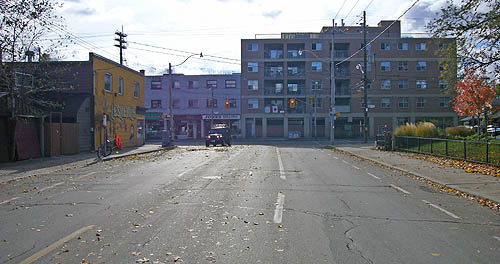
– where, at the western corner, Leslie Grove Park sits. On the eastern corner is the iconic Leslieville mural, featuring that old tribalist Alexander Muir. Heading north from Queen, you face quite a trek.
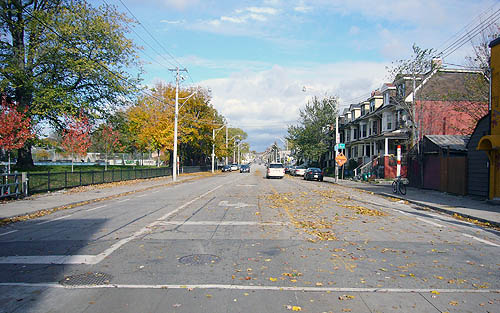
There’s no end in sight, and most of it’s uphill. Off we go.
7 Jones
Be glad you aren’t a courier, because you’re never going to find 7 Jones on your own. It’s hidden behind a laneway –
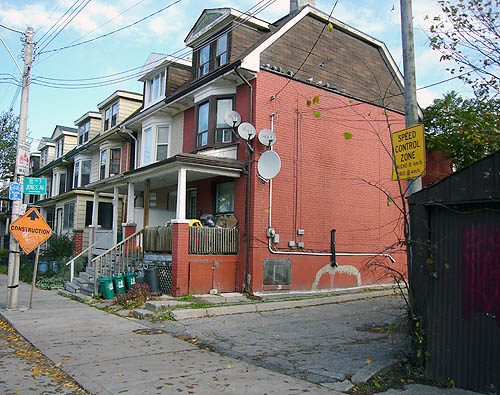
– and once you get there, you find a tiny, ghettoized social-housing complex that is invisible from any major street.

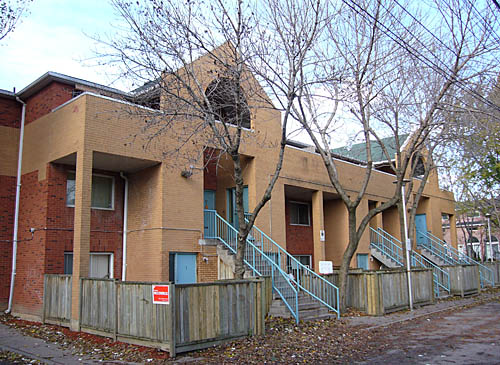
They’re trying to dress it up with the occasional peaked roof, but if you live there you’re marooned. Almost anything could happen and nobody is about to come along and rescue you. Really, there’s almost always something wrong with Leslieville social housing.
52 Jones
You might be lucky enough to live “across the street” at 52–54 Jones, a social-housing complex so well camouflaged you can barely tell it isn’t a single-family dwelling.
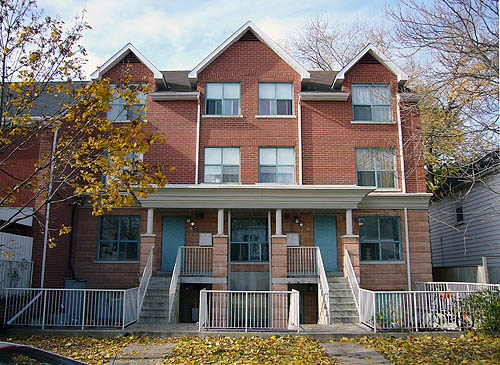
There seem to be no fewer than eight units in that building, half of them basements. There’s a large common backyard at the rear. Judging from the lack of adornment and the general mien of the residents, they are unusually poor. That’s got to be hard for them. But they have an almost-brand-new housing development that blends in well with the street and is almost adjacent to a park.
Frosted layer cakes
A couple of doors up, and alongside a tiny cottage-like shanty, sit two insane confections of bad taste. It’s a pair of duplexes with an aggressively (if imperfectly) square frontage and overwrought entrance steps. Right there they don’t match anything else on the street.
Then there’s the colour. It’s the icing on the cake!
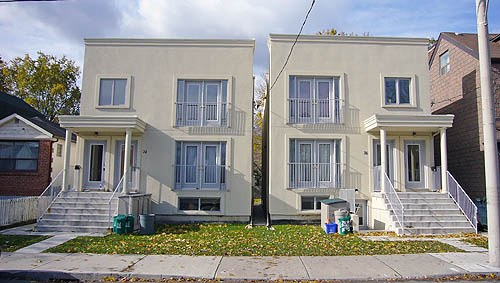
Quick, Marge – my insulin. These icy confections stick out like a sore thumb. They’re barely two years old and we simply could not believe our eyes during the construction process. Moreover, the owners have had trouble keeping them rented (or sold – it may be a mixture, or they may all be condos, some of which are privately rented). It is not entirely clear why they aren’t the same height. Nor is it clear who could convince themselves this was a good idea in the first place.
Maddy Harper Lodge
We aren’t even at Dundas yet and we still have not completed our travels through the land of misplaced architectural tropes. At 86 is the Maddy Harper Lodge, the mad-as-a-hatter postmodern love object by an architect with a point to make. Unfortunately, the point seems unrelated to the lives of Indians and other aboriginals who live there. The glass teepee and the canoe-like ribs over the enranceway do nothing to dissuade us that this building was gathering dust in a cherished folder until somebody with funding came along. It didn’t quite matter who that was; all that mattered was getting the thing built.
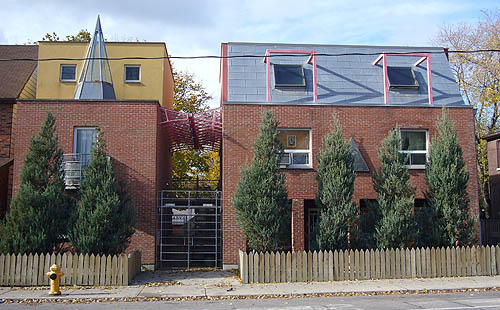
How many postmodern aborginals do you know? Wouldn’t they all be doing performance art in TriBeCa rather than living at Queen and Jones?
Typical housing
We should probably talk more about the classic typology of Jones Ave. housing. Actually, there are several, but the overriding form is post–World War I three-storey row housing.
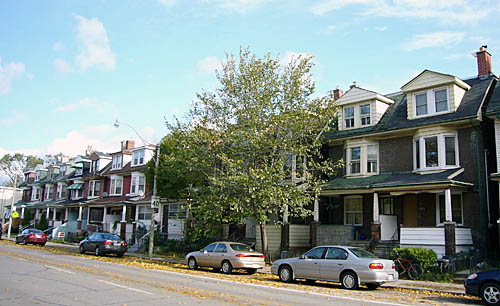
Like so many neighbourhoods’, Jones Ave.’s housing is slowly falling apart – and falling over. We aren’t quite at the Shaw St. stage of adjacent buildings leaning into one another as though they were slipping through a sewer grate, but we’re getting there. A great many of Jones’s houses, which have scarcely any setback and only postage-stamp-sized front lawns, are inhabited by Chinese in late middle age. (Few seem to have any competence in English. Although Chinatown East is only a few blocks away, this too seems like an isolated life, one where you not only don’t know your neighbours, you couldn’t talk to them even if you had to.) Some houses are occupied by straight-up white trash, though it remains inexplicable how they ever afforded a house.
Something of note about Jones housing – below Gerrard, at least – are the simply awful thresholds, porches, decks, and entrances. They’re just fantastically bad, and not only do they make the houses look like they’re in worse shape than they might really be, they’re unwelcoming. The city has a program to fund the improvement of commercial façades; Jones demonstrates how we need that sort of thing for residences too.
Jones Library
I think this building doesn’t get enough credit.
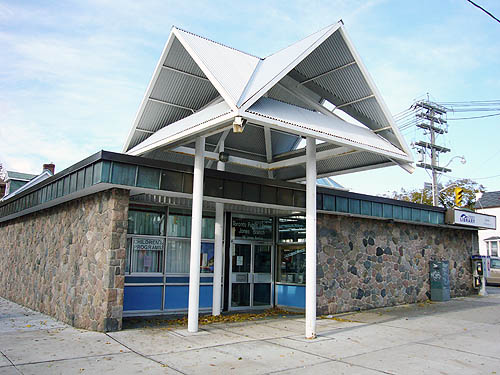
The entrance is covered by a pagodas within pagodas propped up by the original too-thick white pillars. (It’s a replacement for a less busy structure, of which we don’t have a photograph, that began to leak last year.) The washrooms are somewhat too conspicuously located – along the inside north wall on your way to the checkout desk, which in turn sits right beside the men’s room. That’s about it when it comes to complaints.
The Jones Library is a tidy, self-contained slab, complete with stone walls, that is situated approximately in the middle of nowhere. As such, it is one of Toronto’s many hidden Modernist treasures. (And it isn’t really in the middle of nowhere – the walk from Queen to Dundas takes next to no time and the doddering old Jones bus stops right there. Some maintain that the rusticated stone disqualifies the building from Modernist status; Modernist stone is flat[tened].)
Here’s what it looked like in the ’80s, according to a picture on their notice board (rephotographed with permission):
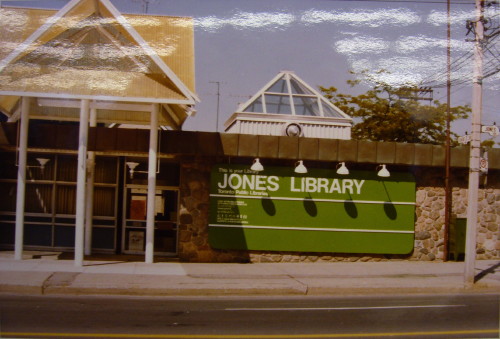
Two years ago the library got a new floor (dark hardwood or a very convincing facsimile) and new shelves. There’s a skylight that is admittedly too bright in the summer. It would be a prototypical neighbourhood branch if it weren’t such a nice piece of architecture. And because it’s named after the street, it too has a weirdly baldfaced and barren name, the kind of thing that puts you off from dropping by to visit. What a surprise once you see the place.
Those troublesome garages
All is not well, however, at Jones and Dundas. There’s a hideous house at the southeast corner with an front step abutting the sidewalk. But kitty-corner is a row of dilapidated, but brightly painted, garages.
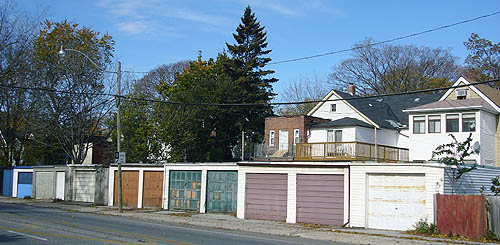
They’re a symptom of a suburban typology misapplied to “downtown” Toronto. It seems nobody anticipated that the area south of Dundas would be opened up and subjected to public view.
This is the sort of thing that could be rejuvenated in the neo-Newfoundland, neo-Scandinavian Jones style, to be described shortly. Some structural improvements, such that the garages aren’t leaning into each other anymore, would be a good place to start, at which point they can be brightly coloured as a sort of Mondrian mural.
This isn’t the Danforth
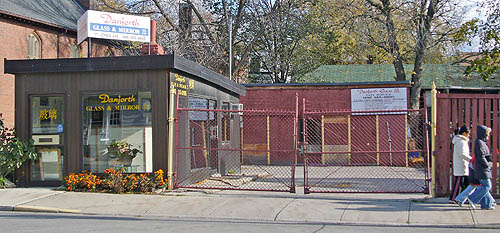
That’s a lot of land for such a tiny building, and you aren’t anywhere near Danforth Ave.
Curiosities at Gerrard
Jones and Gerrard is a great place to buy Chinese bubble tea or hold a funeral for your Chinese relatives. It’s also a great place to go to school, as the palatial, and aspirationally named, Riverdale Collegiate Institute (RCI) dominates the corner. It’s so big you can only photograph the whole thing from a helicopter.
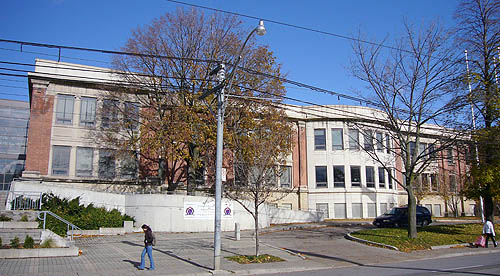
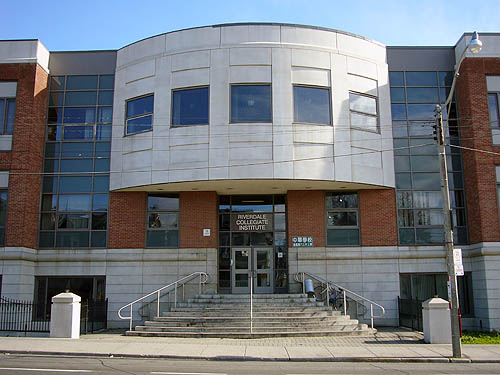
RCI so oversubscribed that student crowding undoes whatever benefits the brand-new building might bring.
Mishmash of eras
Up here, you get your standard mishmash of eras with housing.
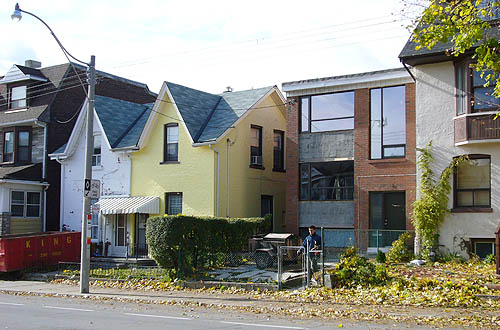
And a mishmash of states of repair, obviously.
But things get really interesting when you round the corner twice – onto Sproat Ave. and then down the laneway named Peyton.

It’s the home of Peter Duckworth-Pilkington and Suzanne Cheng. They’re architects (obviously – the building reeks of “architect’s house”). Unlike the architect’s house on Knox, this one isn’t trying to stare down or upbraid its neighbours. If you’re going to plunk down a confection like this in an old neighbourhood, at least make it a destination rather than something people are stuck looking at every day of the year.
Now we have to deal with the hill
Jones is uphill most of the way, but only now, as you pass the tiny Greek Orthodox church – obviously an old house on which indignities have been fomented – do you start to notice.
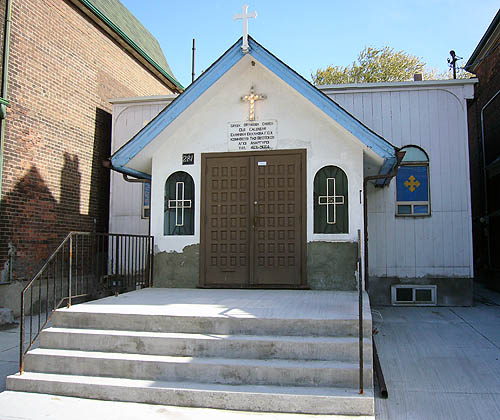
The little residential enclave just to the east of here, whose backbone is the very uppermost tip of Leslie St., is actually a pleasant place to raise bored and understimulated children or to wither away and die. And one of its streets has the deliciously retro name of Myrtle Ave.
We’re getting closer to the train tracks, where the houses like each other enough to grow catwalks over their driveways.
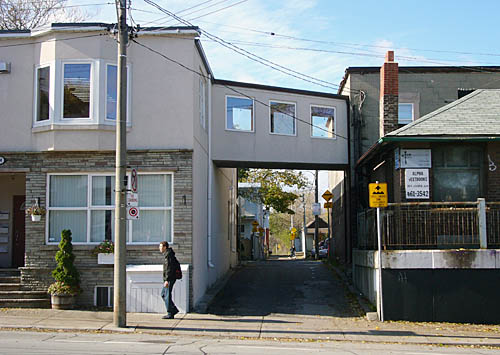
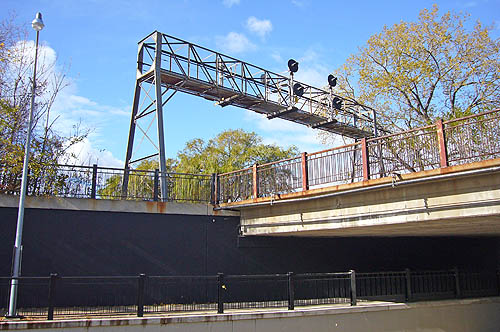
The train tracks force you to climb the summit of the hill, dip down again, and climb an even steeper grade on the other side. If you’re really clever you can stand on the northeast embankment and look straight down Boultbee to the elementary school. It is presumably those students who have decorated the ominously black walls of the underpass (built 1951, according to the inscription).
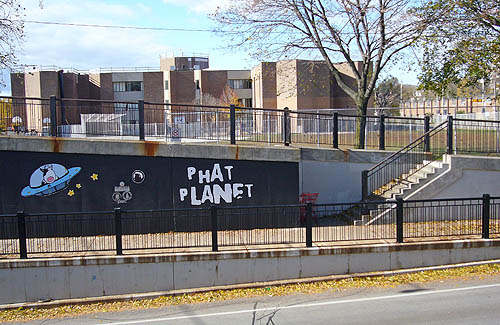
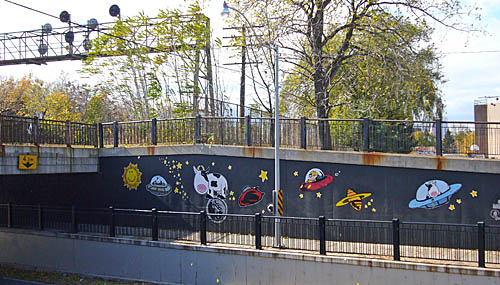
Painted ladies
I don’t know why the hipsters don’t run little tours of this stretch of Jones, the way they do of the guy’s house on Clinton decorated with thousands of little spools, or the old kook’s house on Simpson that “accidentally” burned down. Because we’ve got a little slice of St. John’s – or Stockholm – right here on Jones in the form of a stretch of houses painted insanely garish colours.
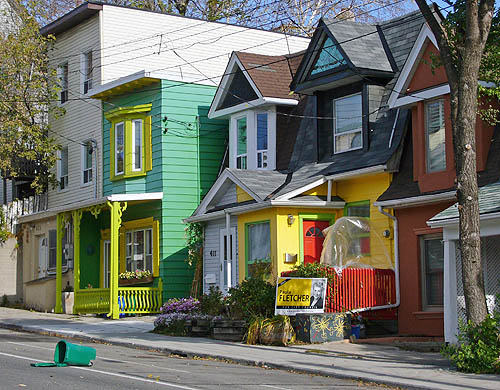
That isn’t forced perspective. The houses really are that narrow and they really do jam against each other. (And that really is somebody’s recycling bin blown into the street on this windy day.)
The colours... they’re like icing sugar on a postmodern birthday cake, aren’t they? And actually, one kind of pities the occupants of 411 Jones, sandwiched between their lime-and-citron neighbours.
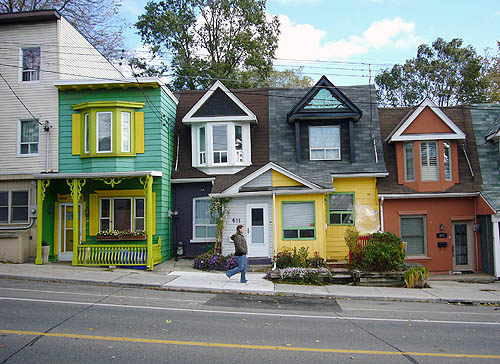
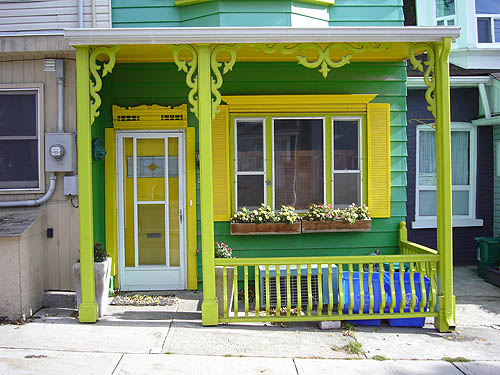
A cold, blustery day makes the paint seem even less real. It makes the colours seem like an insult to nature. Because they are – and that’s why people in Scandinavia and Newfoundland paint their houses that way. We will not give in to winter without a fight.
Also up here, there’s the variety store, half of whose sign is vintage, the other half as tacky as Microsoft Windows typography can be.
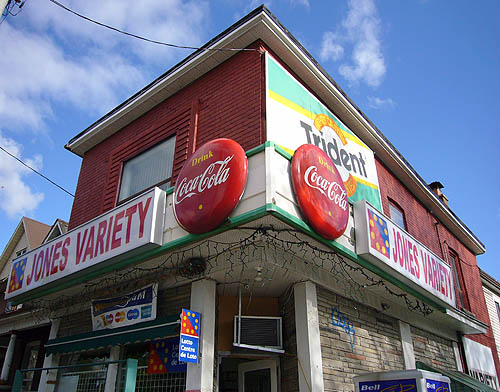
Do the dead need a variety store? And do they sell kosher?
Goel Tzedec
The oldest Jewish cemetery in the city that still accepts interments, Goel Tzedec Cemetery sits seemingly implausibly near the top of Jones Ave.
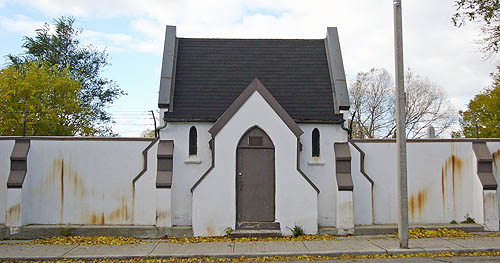
But east-end Toronto used to be an ethnic (including Jewish) ghetto, and there’s another Jewish cemetery in the neighbourhood, on Pape south of Gerrard.
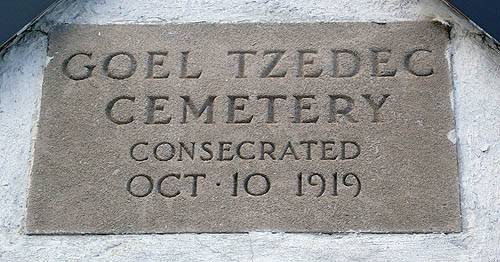
The inscription over the gate is misleading. The actual contemporary official name is Jones Avenue Cemetery, חברה קדישה חסד של אמת.
This place has quite a bit of lore surrounding it – that you can knock on the door of the neighbouring house (which one?) and ask for a tour, that the key to the gate is inside the screen door of a nearby house (which one?). This Jewish cemetery hides in plain sight on a street that, despite having an actual bus line, also hides in plain sight.
Grand but crumbling
A bit further up the street is a grand old school.
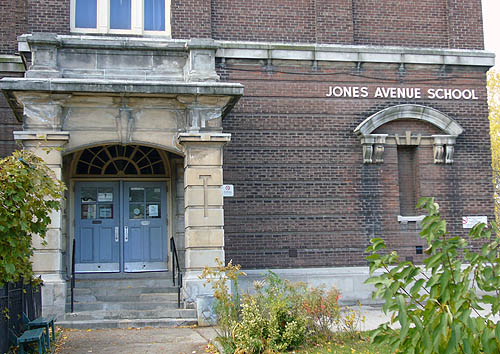
But we now know all too well that old schools in Toronto may look nice and may evoke pleasant memories for older people, but they’re all falling apart, they aren’t very accessible to kids in chairs, and heating and air conditioning leave a great deal to be desired. A new school, like RCI, is “better” in all practical ways.
Within sight of Danforth
Jones tends toward miscellany the closer you get to its upper limit. There’s the Estonian church, the Modernist slab (one of dozens scattered throughout the city), the black barbershop, the New Apostolic Church.
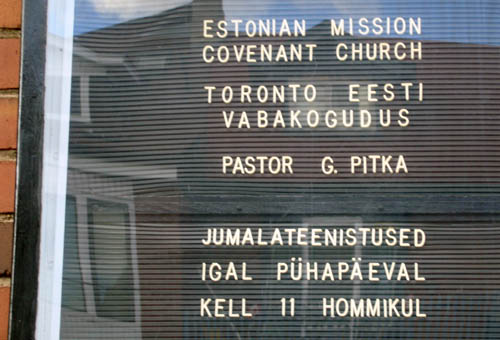
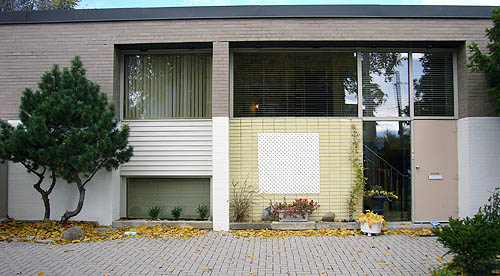
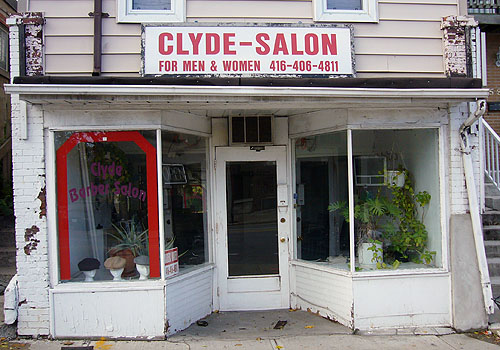
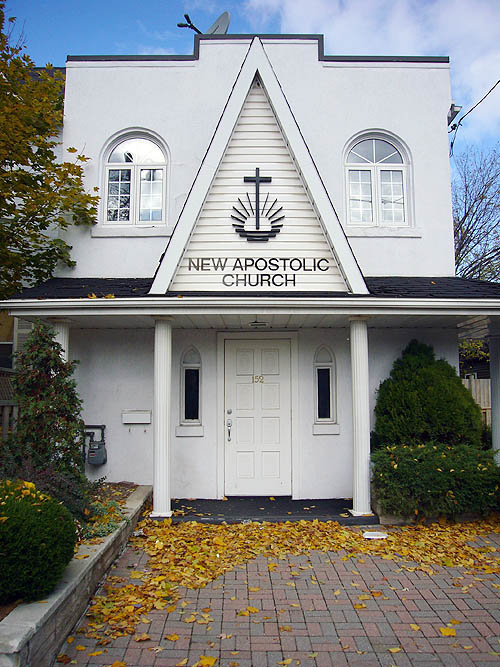
At this point you’re pretty tired. And the outlook is rather bleak, with three lanes of cars and two bike lanes. (The bike lanes almost completely unused. If you can struggle past the train tracks, it’s downhill almost all the way. Then there’s the return trip, of course.)
Motorama
You’ve got one last glimpse of the 1950s, the iconic Motorama Restaurant.
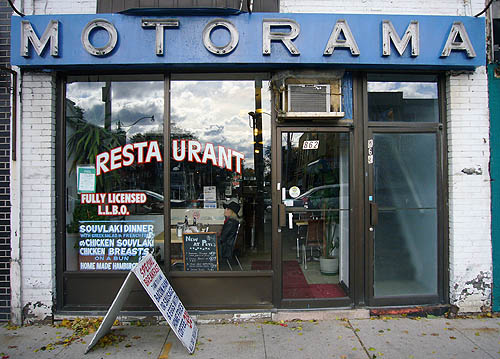
Fortunately for us, Motorama is still there. But if you’re the owner of one of the arriviste houses on Jones, the ones that stand half a storey too tall and use all the wrong kinds of bricks, you wouldn’t be caught dead there. (And we won’t run pictures of your houses, either.) You’re more apt to drive your Beetle Convertible up to the oddly situated Starbucks, whose vitrine is a pleasant place to watch the interplay between the posh and dodgy ends of Danforth Avenue.
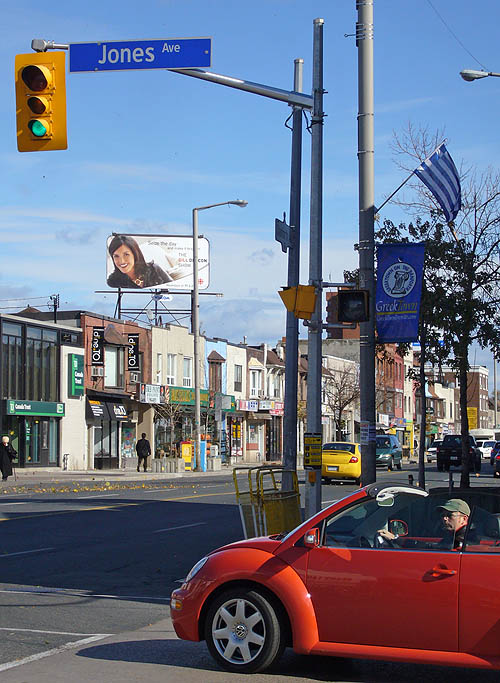
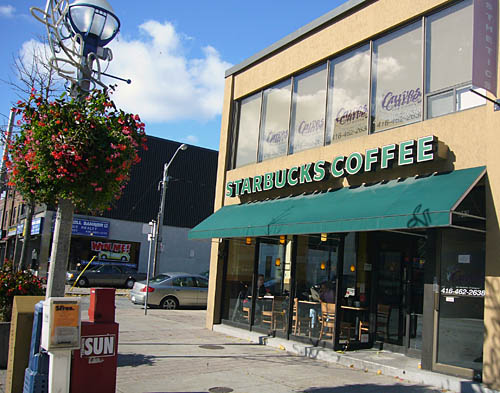
You can have your coffee there no problem. You deserve a rest. You’ve slogged uphill through an unsung piece of Leslieville history. You have succeeded at Doing Jones.